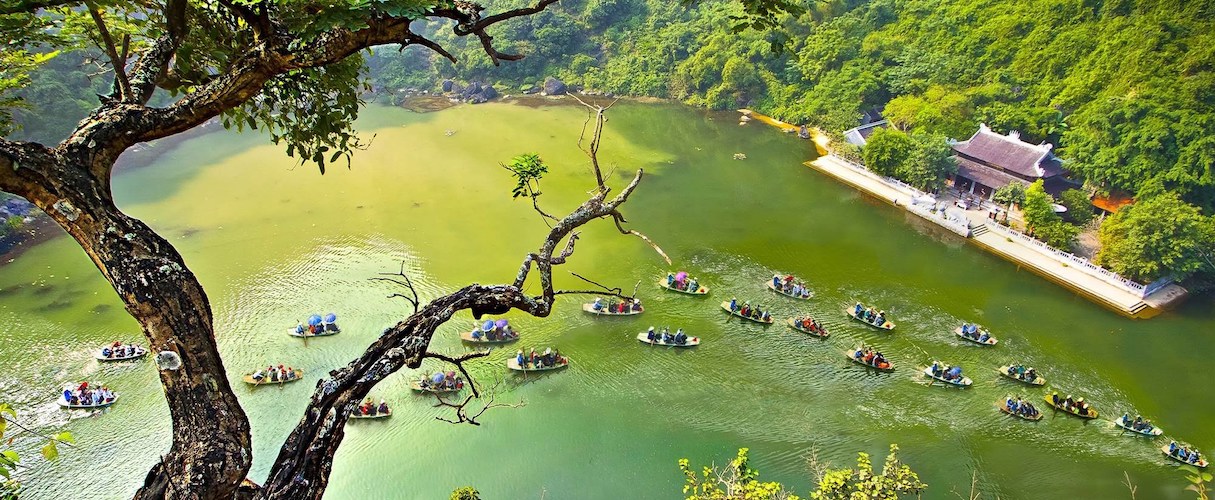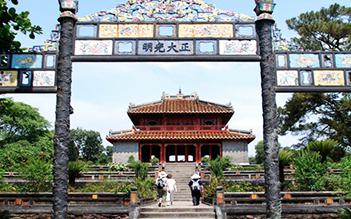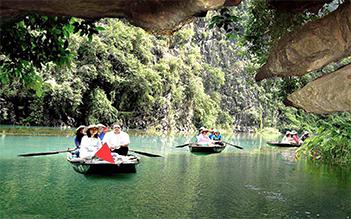Overview
Trang An is an eco-tourism site located in Trang An World Heritage Complex in Ninh Binh province. It has been ranked by the Government of Vietnam as a particularly important national monument and recognized by UNESCO as a dual world heritage since 2014. Trang An with a system of limestone mountains with geological age of about 250 million years, through a long time-weathered by the transformation of the earth, the climate, the sea progressed, and the sea receded brought in hundreds of valleys, caves, and lakes.
Overview of Trang An
This landscape is a place to preserve and contain many submerged forest ecosystems, limestone forests, archaeological sites, and cultural and historical relics. The system of rocky mountains, rivers, forests and caves in Trang An is very dangerous, so it was chosen by King Dinh Tien Hoang to become the Southern citadel to protect Hoa Lu capital in the 10th century and then Tran Dynasty used it as Vu Lam's palace. in the Nguyen Mong resistance war. Currently, there are many historical relics of Dinh and Tran dynasties.

Trang An
Location
Trang An is located 3 km south of Hoa Lu ancient capital, 7 km from Ninh Binh city in the west, 16 km from Tam Diep city in the north, 96 km from Hanoi. Trang An - Tam Coc core zone has an area of ??more than 6,172 ha, which is a special protection area of ??scenic spots. This special protected area is located in Hoa Lu forest, belonging to Hoa Lu ancient capital preservation area and also belonging to the Trang An World Heritage site with an area of ??12,252 ha.
In the Trang An landscape complex, the center of Hoa Lu ancient capital is in the north, Tam Coc - Bich Dong tourist area is in the south and Trang An eco-tourism area is in the central position. These three areas are linked together by Hoa Lu forest on limestone mountains, rivers, lakes and swamps. In addition, this area is very close to other tourist attraction sites such as Mua Cave, Van Long lagoon, etc.
Natural landscapes
The cave system

Trang An
Trang An has up to 31 lakes, lagoons connected by 48 caves, including 2-kilometer long caves such as Dia Linh cave, Sinh Duoc cave, May cave ... Each cave has a characteristic appearance.
In the Trang An landscape complex, many caves are recognized as archaeological relics, they are being studied by British scientists such as:
- Drum cave is a cave with many relics, traces of prehistoric people from 3,000-30,000 years ago, showing traces of Trang An culture Fortune-telling cave is located in the middle of Truong Yen and Gia Sinh communes, where there is imprints of ancient inhabitants living between 5,000 years and 30,000 years ago, showing vestiges of Trang An culture.
- Relics of Thung Binh stone roof (Gia Sinh - Gia Vien) reveal traces of Hoa Binh cultural inhabitants.
- The cave cluster of Mo cave, Co cave, Buffalo Cave, Hu Ngoai cave, Hu Trong cave has the imprint of Hoa Binh culture and Da But culture.
- Cho cave stone roof relic (Ninh Hai - Hoa Lu) has Hoa Binh cultural layer over 10,000 years ago.
Landscapes
Unlike Tam Coc, which is a form of boating on the river and Van Long is a large ecological lagoon, Trang An can create many journeys on the river without having to go back. This cave complex is likened to a tragedy; mountains, lakes and caves form continuous layers of citadel. The wonderful thing in Trang An is that the lakes are interconnected by caves. These caves convey convection water flowing from one ravine to the other. The mountains swarmed around the lake and in the middle emerged the land with the forest growing into this island. Far away on the mountainside, under the canopy of the magnificent forest, there are mountain goats climbing on the rocks.




